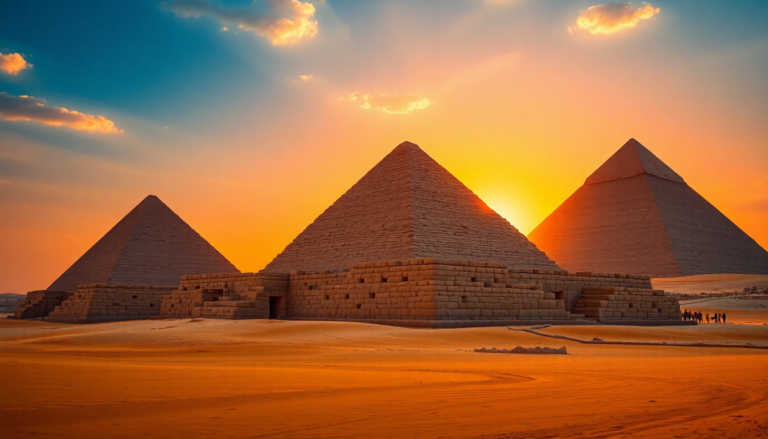Argomenti trattati
Imagine standing before colossal structures that have witnessed the rise and fall of civilizations. The Pyramids of Giza, with their imposing forms piercing the Egyptian skyline, are not just remnants of a bygone era; they are living symbols of humanity’s quest for immortality. Built over 4,500 years ago as grand tombs for the pharaohs, these ancient wonders continue to inspire awe and curiosity. I remember my first glimpse of them— it felt as if I had stepped into a time machine, transported to an age where gods walked among men.
Getting to Giza
Contrary to popular belief, the Pyramids do not sit in the heart of Cairo but are located in Giza, about 20 kilometers away from the bustling capital. As you travel along Al Haram Street, the scenery shifts dramatically— the urban chaos gives way to expansive desert landscapes. One moment you’re engulfed by the noise of the city, and the next, you find yourself in a serene expanse, with the ancient sentinels rising majestically from the sands. It’s a surreal transition, almost like a pilgrimage to the cradle of civilization. The journey takes just half an hour (or a bit longer depending on traffic), yet it feels so profoundly epic.
The Great Pyramid of Khufu
At the center of Giza’s complex lie three monumental pyramids: Khufu, Khafre, and Menkaure. The Great Pyramid of Khufu, also known as the Pyramid of Cheops, is the tallest and oldest among them, originally soaring over 147 meters. Today, due to centuries of erosion, it stands at approximately 137 meters. Each side of its base stretches nearly 230 meters, constructed from over two million limestone blocks. Just standing there, gazing up at this architectural masterpiece, leaves you in utter disbelief. How did they do it? Who were the skilled hands behind such a monumental feat? It’s questions like these that keep history enthusiasts like myself utterly captivated.
The Pyramid of Khafre
Next to Khufu, the Pyramid of Khafre appears taller, but it’s merely an optical illusion thanks to the terrain. Remarkably, it still retains some of its original Tura limestone casing at the peak, a remnant of the once-glimmering exterior that would dazzle in the sun, turning the pyramids into colossal beacons of light. Standing near it, you can almost feel the echoes of the past whispering tales of the pharaohs.
The Pyramid of Menkaure
Then there’s the smaller yet equally impressive Pyramid of Menkaure, rising to 66 meters with a square base of approximately 100 meters per side. It’s like a hidden gem between two giants, boasting its own unique charm. The architectural finesse and harmonious proportions of this pyramid make it an undeniable presence, worthy of admiration.
The Enigmatic Sphinx
As you wander around, you can’t miss the Sphinx. Even before you see it, there’s an unmistakable aura of enigma surrounding the area. This colossal sculpture, carved from a single block of stone, portrays a lion with a human head and stands guard near Khafre’s pyramid. It embodies the essence of Egyptian mystery. What was its true purpose? Was it merely a guardian of the necropolis, or did it symbolize the pharaoh’s divine nature? The answers elude us, and perhaps that’s the magic of the Sphinx—its secrets remain locked in time.
Legends and Discoveries
The Pyramids of Giza are not just historical artifacts; they are a treasure trove of legends and stories that have intrigued scholars and adventurers alike. Surprisingly, many details surrounding their construction are still shrouded in mystery. For ages, it was believed that they were built by slaves, but recent archaeological findings have flipped that narrative. Evidence suggests that the laborers were skilled craftsmen, well-fed and organized into teams, living in nearby villages equipped with bakeries and even rudimentary medical facilities. A remarkable system of production that speaks volumes about the sophistication of ancient Egyptian society.
And let’s not forget Thales of Miletus, the ancient Greek philosopher credited with being one of the first to measure the height of the Great Pyramid. Without fancy tools, he relied on the shadows cast by the sun, using a simple rope to calculate proportions. It’s a fascinating blend of observation and mathematical logic at a time when science was just beginning to take shape.
A journey worth taking
Visiting the Giza Pyramids is more than just a trip; it’s an experience that connects you with the very essence of human history. Each stone, each inscription tells a story, inviting you to ponder the mysteries of the past. As I stood there, taking it all in, I felt a profound sense of connection—not just with the ancient world, but with every traveler who had come before me, each one seeking to unravel the secrets of these magnificent structures.
So, if you ever find yourself in Egypt, make sure to carve out some time to explore these wonders. You never know what insights or inspirations you might carry home. After all, as many know, the past has a way of shaping our understanding of the present—and what could be more timeless than the Pyramids of Giza?

